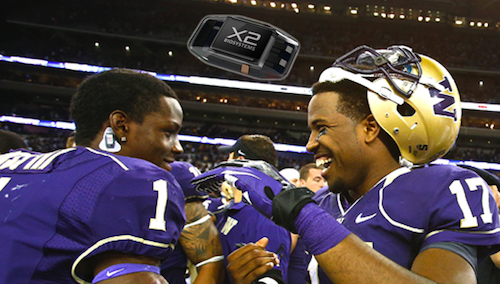
X2 Biosystems’ XPatch provides data for early detection of head injuries.
Product Design faculty member Jeff Higashi spent over three years inside NFL players heads. As Vice President of Product Development assigned to develop a device that would capture data to assess potential concussions, Higashi gave a lot of thought to the mechanics of the sport as well as to how the players and teams might best be served by what players wear on the field and how.
With Sunday’s Superbowl showdown between the New England Patriots and the Seattle Seahawks swiftly approaching, we asked Jeff to explain how the X2 Biosystems’ XPatch device he helped develop might help protect players from the plague of concussions afflicting the sport. And we also seized the opportunity to ask this wearable tech designer to analyze some of the messages these two formidable teams are sending via their uniforms’ color, materials and design elements.
The Dotted Line: Can you describe the device you created for football players and its intended function?

Product Design faculty member Jeff Higashi
Jeff Higashi: The concussion issue is definitely something that needs to be addressed and the NFL is working to address it. I’ve worked with X2 Biosystems, which developed the official software the NFL uses to do baseline assessments. The assessment involves a series of mental awareness, coordination and memory tests that are conducted before the season starts.Throughout the season and when injuries occur, players get checked out and responses to the test are compared with their baseline assessment. The results are reported to the team doctors as well as the NFL so recommendations can be made to increase the safety and health of the player.
I worked on this project for about three years. The main role I played with X2 Biosystems was designing the product: a patch that goes on the back of the ear, which can be used for sports or military applications. X2 Biosystems was just awarded a contractwith the Department of Defense to put the patch into use with soldiers, primarily in the US because many injuries occur in basic training. Injuries often go unreported during training because soldiers are often trying to prove themselves and don’t understand the dangers they can face with head injuries. We’re taught to “shake it off” or “work through it” and these coping mechanisms can end up being damaging to our health.
The patch has several sensors: a motion sensor, a clock, a gyroscope, and other data collecting tools. Basically it detects data surrounding impacts. The data it tracks includes the force, rotation of the head (speed and force of head whipping side to side), as well as the overall displacement of head. There’s no exact science to tell if you have a concussion. The g-force of the impact and the rotational value can often be revealing variables to help better assess the possibility of a concussion. Providing this data to Neurologists and trained physicians will aid in making an informedassessment of whether a concussion has likely occurred.
TDL: Have any teams adopted the device? And if so, what kind of results do you hope to see?
JH: We’ve deployed about two thousand devices to NCAA athletic programs including football, boxing, rugby and field hockey. At many colleges, the neuroscience and athletics departments are getting together to use the tool to study concussions. We have also trialed it in the NFL; but has not been adopted yetbecause there’s a players union that needs to accept everything a player wears. But I think it’s inevitable that they’ll ultimately want and have to adopt it.
TDL: From a design perspective, would you critique/analyze the uniforms of each team in terms of color, logo and overall aesthetics?
JH: Uniforms say a ton about a team. New England is a very traditional organization. Their uniform reflects that. Although they made a major change years back they’re still using that old school stripe around the arm you see from decades past. The typography used on their name and numbers has been more traditional. It’s pretty old fashioned and conservative. That seems to stem from the ownership and the kind of team they’re building. They have a traditional program, coach and cast of players. Their coach in particular is very old school.
On the opposite spectrum, the Seahawks’ uniforms is much more progressive. They use a newer, modern typeface for their names and numbers – more stylized. In the old days, NFL teams would never do anything like. The fact that they have lime green in their color pallet is also very avant-garde. That forward-thinking approach is also reflected in their style of play. The quarterback is a new style hybrid player. The coach is known to be more experimental which comes from his experience in college football and the teams’ overall demeanor is very progressive. It’s kind of like old money and new money. Or to use a local geographic analogy: It’s Venice and Bel Air.
TDL: In terms of functionality, what kind of changes would you make to improve the uniforms and safety gear worn by players in the NFL?
JH: There have been a ton of changes most fans don’t realize. The shoulder pads have been completely redone over recent years. They’re carbon fiber with open cell foams, which are better at absorbing impacts and increasing mobility. The materials and design help with impact dissipation. Like a Formula One car is designed to distribute the force around the chassis. That’s what these pads are designed to do: prevent the impact to one zone and spreading that around. Russell is one of the companies that’s been innovating these new shoulder pads in their CarbonTek products
Design has been very influential in creating protective gear that’s made more breathable and enables players to be more mobile. In recent years, players haven’t wanted to wear much protective equipment because they perceive that it makes them slow. Players have been opting not to wear traditional pads such as knee and thigh pads. I think the number of injuries is increasing however and looks like the NFL may require they reintroduce these pads going forwards. Newer materials and design have been developed which should help players achieve the mobility and freedom they seek without compromising safety.
TDL: When do you anticipate your concussion device will be adopted by the NFL?
JH: Hopefully the XPatch device will be implemented soon. Its real potential involves enabling doctors to look at head impact data over time and detect the likelihood of having long term traumatic brain injury. Players don’t usually notice problems when they’re active players. Its only later that they often realize they’re in bad shape. Then, later many start suffering from memory loss, dizziness, nausea and depression. There are a lot of negative effects to head injuries. The XPatch device would give players some quantified information about how much exposure to impact they have so they can make informed decisions about their health before it’s too late.








